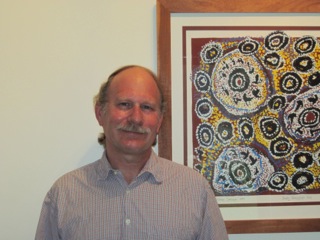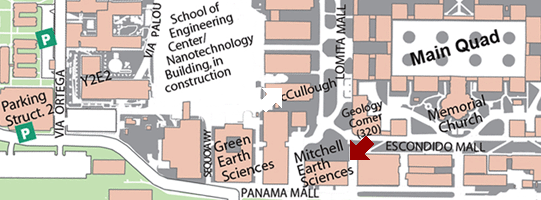
Presents
Location: Stanford University
This will be the 439th meeting since 1954
Subduction at the Franciscan trench began ca. 165 Ma and continues today off northernmost California. The Franciscan accretionary prism has been assembled over this period. Prism growth has been mainly by progressive accretion of trench sediments and related materials at the leading, seaward, western edge of the prism. In a progressive accretion model, rock units should generally young seaward and structurally downward. In the past, however, Franciscan rocks have proven extremely difficult to date, complicating evaluation of such models. The on-going revolution in detrital zircon U-Pb dating has upended this obstacle and now DZ age distributions can easily be determined for essentially any Franciscan sandstone sample.
Story #1: The South Fork Mountain Schist (SFMS) forms the eastern margin and structural top of the Franciscan prism and so was apparently the first unit of substantial size to accrete into the Franciscan. DZ ages and Ar/Ar ages of metamorphic white micas show that the SFMS accreted surprisingly late in the time span of Franciscan subduction, probably at ca. 123 Ma. At least parts of the structurally underlying Valentine Spring Formation and Yolla Bolly terrane accreted soon thereafter. Therefore, accretion of the SFMS apparently marks a fundamental transition from virtually nonaccretionary behavior to strongly accretionary behavior in the Franciscan forearc. About 75% of modern forearcs are nonaccretionary, so recognition of an early nonaccretionary period is consistent with modern examples. Interestingly, the transition into an accretionary regime at ca. 123 Ma was essentially synchronous with the end of the Late Jurassic–Early Cretaceous magmatic lull in the Sierra Nevada magmatic arc.
Story #2: The major Yolla Bolly terrane (YBT) has stood out as an anomaly for a progressive accretion model. The YBT contains about 20 published Buchia fossils sites scattered extremely sparsely over ~4000 sq km of outcrop area. The Buchia ages and other data have been interpreted to indicate protracted deposition of continent-derived, trench-style sediments from ca. 151 Ma through 136 Ma, followed by accretion at ca. 95 Ma. However, this time of deposition greatly pre-dates the final deposition and accretion of the more inboard SFMS. This relationship has required that the Yolla Bolly basin was filled and then "stored" somewhere far from it's current location from ca. 151 to 95 Ma, to escape involvement in SFMS accretion. However, there were reasons to be suspicious that some of the Buchia may have been redeposited. We obtained DZ data from six of the best-documented Buchia sites. Four sites yield robust youngest DZ populations of mid-Cretaceous age (ca. 110-96 Ma) and two yield non-definitive results. At the most revealing site, abundant Buchia were discovered inside clasts within conglomerate, incontrovertible evidence for fossil redeposition. We infer that all Buchia in the Yolla Bolly terrane proper are redeposited and the terrigenous sediments that comprise most of the terrane are much younger than previously supposed. This resolves the Yolla Bolly anomaly, making the YBT's structural position within the Franciscan prism compatible with a simple progressive accretion model. Although only limited data are yet available, the extremely rare Buchia in the Franciscan Central belt, which lies outboard of the Yolla Bolly terrane and so should be younger still, are probably all redeposited as well.
Story #3: DZ ages indicate that a substantial part of the major Coastal belt subunit of the Franciscan represents a massive, relatively brief surge of near-trench deposition and accretion during Eocene time (ca. 53 to 49 Ma). Sediments were sourced mainly from the distant Idaho batholith region rather than the nearby Sierra Nevada. Idaho detritus also fed the Eocene Great Valley forearc basin of California, Tyee forearc basin of coastal Oregon, and Green River lake basin of Wyoming. Plutonism in the Idaho batholith spanned 98 to 53 Ma in a contractional setting; it was abruptly superseded by major extension in the Bitterroot, Anaconda, Clearwater, and Priest River metamorphic core complexes (53-40 Ma) and by major volcanism in the Challis volcanic field (51-43 Ma). This extensional tectonism apparently deformed and uplifted a broad region, shedding voluminous sediments towards depocenters to the west and southeast. In the Franciscan Coastal belt, the major increase in sediment input apparently triggered a pulse of massive accretion, a pulse ultimately controlled by continental tectonism far within the interior of the North American plate, rather than by some tectonic event along the plate boundary itself.
References: Dumitru et al., 2010, Tectonics; Dumitru, 2012, AGU poster T11A-2543; Dumitru et al., 2013, Geology.

Trevor Dumitru
Trevor Dumitru received his degrees from Harvard, UT-Austin, and the University of Melbourne, then arrived at Stanford in 1990 to set up the new fission track dating laboratory. He has been a research associate at Stanford since then, with interludes away working as a consultant. His main interests are the development of laboratory methods for geochronology and the Mesozoic-Cenozoic geochronology and tectonics of the western U.S.
[Note: Mike will be out of town; please reply to Joe Colgan jcolgan@usgs.gov]
Reservations: The preferred way to make reservations is simply to email Joe Colgan at jcolgan@usgs.gov by April 7, tell him you will attend, commit to pay, and bring your payment to the meeting. Joe always emails a confirmation; if you don’t get one, assume email crashed yet again and email him a second time. A check made to “PGS” is preferred, payable at the meeting.
If you want to pay in advance:
Everyone (including Stanford folks now) Please make dinner reservations by April 7. Contact Joe Colgan, at U.S. Geological Survey, 345 Middlefield Road, MS-973 Menlo Park, CA 94025, Tel.: (650) 329-5461. Send check made out to "PGS" to Joe.
Dinner and the social hour is $35.00; this includes $5 that we use to help pay for students who are only $8.00 (also partially subsidized thanks to the School of Earth Sciences, Stanford University (Note, no-show reservations owe the full price).
Doris, whose wonderful crew prepares our meals, asked that we let you know that people who are late RSVPing and people who show up without a reservation will be welcome but that they will be eating on paper plates with plastic utensils (food supply permitting).
Dues for Academic Year 2012-2013 ($10.00) should be sent to Mike Diggles, U.S. Geological Survey, 345 Middlefield Road, MS-951, Menlo Park, CA 94025. Mike’s phone: (650) 329-5404.
Officers: Joe Colgan, President; Mike Diggles, Secretary-Treasurer; Elizabeth Miller, PGS Stanford University Coordinator

Date created: April 2, 2013
Last modified: April 2, 2013
Created by: Mike Diggles, Webmaster-Secretary-Treasurer, PGS.